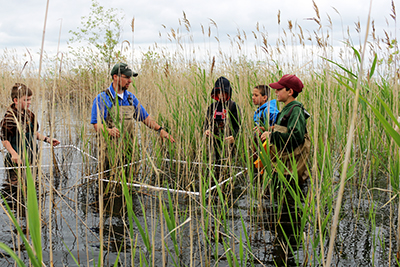Au Gres-Sims students partnering to protect threatened Pitcher’s thistle on Charity Island
Students are committed to studying the impact of the control measures on the invasive phragmites and the threatened Pitcher’s thistle on Charity Island in the Saginaw Bay.

Au Gres-Sims fifth grade students, along with their teacher Michael Fields, ended their school year with a return trip to Charity Island, where they began a long-term study networked by the Northeast Michigan Great Lakes Stewardship Initiative. The study involves partnerships with Huron Pines, the Wiltse Family, Michigan State University Extension, Michigan Sea Grant, Michigan Natural Features Inventory biologists as well as the U.S. Fish & Wildlife Service. Students are committed to studying the impact of the control measures carried out by Huron Pines on the invasive phragmites (Phragmites australis) and the threatened Pitcher’s thistle on Charity Island. Charity Island is located in the middle of Saginaw Bay, about three miles offshore from Au Gres, Michigan. It is owned primarily by the U.S. Fish & Wildlife Service with the Wiltse family retaining ownership of the lighthouse. This 222-acre island has about three miles of shoreline, offering an ideal habitat for the invasive phragmites.
In the fall of 2015, students traveled to Charity Island and used Global Positioning System (GPS) units to mark the location of the invasive phragmites and the threatened Pitcher’s thistle. Students practiced identifying ages of Pitcher’s thistle at their school with MSU Extension and Northeast Michigan Great Lakes Stewardship Initiative prior to their trip. On the island, students rotated through stations. At one station, they carefully canvased the dunes, collecting data on the location and age of Pitcher’s thistle. At another station, students plotted the range of the invasive phragmites and collected information on the density of the phragmites infestation. A botanist with Michigan Natural Features Inventory was on-hand to collect Pitcher’s thistle seeds as well as help strengthen the student’s identification skills and confirm the ages of the Pitcher’s thistle.
Students were excited by the number of Pitcher’s thistle found in some areas, and concerned by the reduction in numbers in areas where the phragmites had begun growing. The collected seeds were transported to a Michigan resident who has experience growing native species. He will germinate the seeds in a protected environment and return the adult plants to Michigan Natural Features Inventory and the students to plant back at Charity Island in the fall of 2016.
This spring, students returned to Charity Island with numerous partners to collect new data on the range and density of the invasive phragmites as well as the location and age of Pitcher’s thistle plants. Students worked in two groups. One group canvased an unrecorded section of the dunes, collecting additional data on the location and age of Pitcher’s thistle plants. The other group donned waders and traveled through stands of invasive phragmites. Students were hoping to find a reduction in the range and density of the stands, as most had been chemically treated by trained members of the Huron Pines staff. Students used a meter square to calculate the density of the phragmites stands and the ratio of dead to live plants. They were happy to see a reduction in the number of live plants, and are interested in the data the 2016-17 fifth graders will collect when they return next fall and spring.

Brandon Schroeder, MSU Extension Sea Grant, using a meter square with Au-Gres-Sims fifth graders to determine the density of the phragmites.
Au Gres-Sims School District has embraced Place-Based Education as a means of strengthening their students’ educational experience, building stronger communities and developing stewards of the Great Lakes. To learn more about Place-Based Education in Michigan, visit the Northeast Michigan Great Lakes Stewardship Initiative website.
To learn more about MSU Extension, visit the MSU Extension website. To learn more about 4-H and MSU Extension opportunities in Arenac County, stop by our Standish office at 120 N Grove St., Standish, MI 48658, or visit us online at our Arenac County 4-H Facebook page or Arenac County 4-H website.
For more ways to share science with youth in your life, please explore MSU Extension’s Science and Technology website. For more information about 4-H learning opportunities and other 4-H programs, contact your local MSU Extension office.



 Print
Print Email
Email



